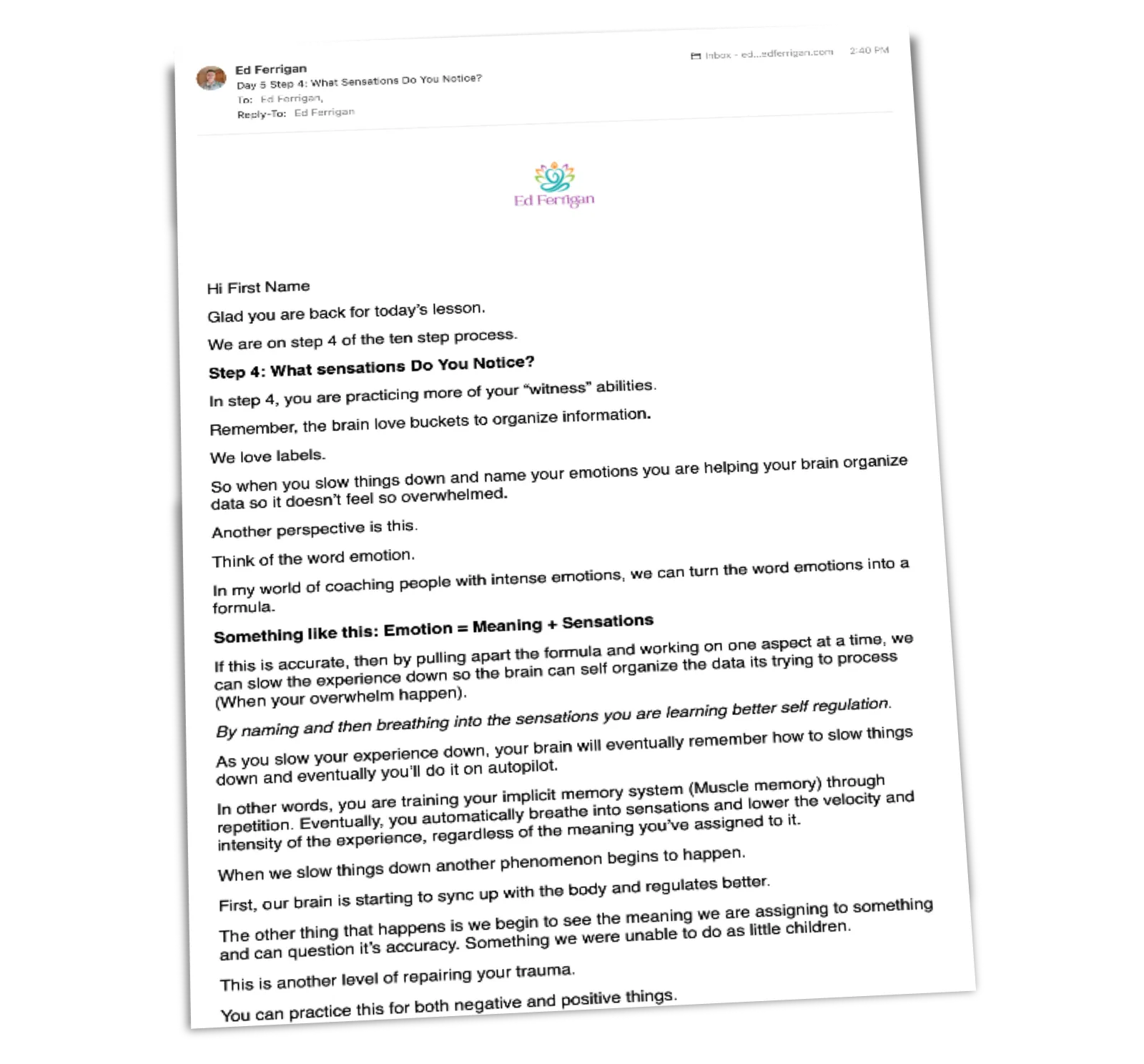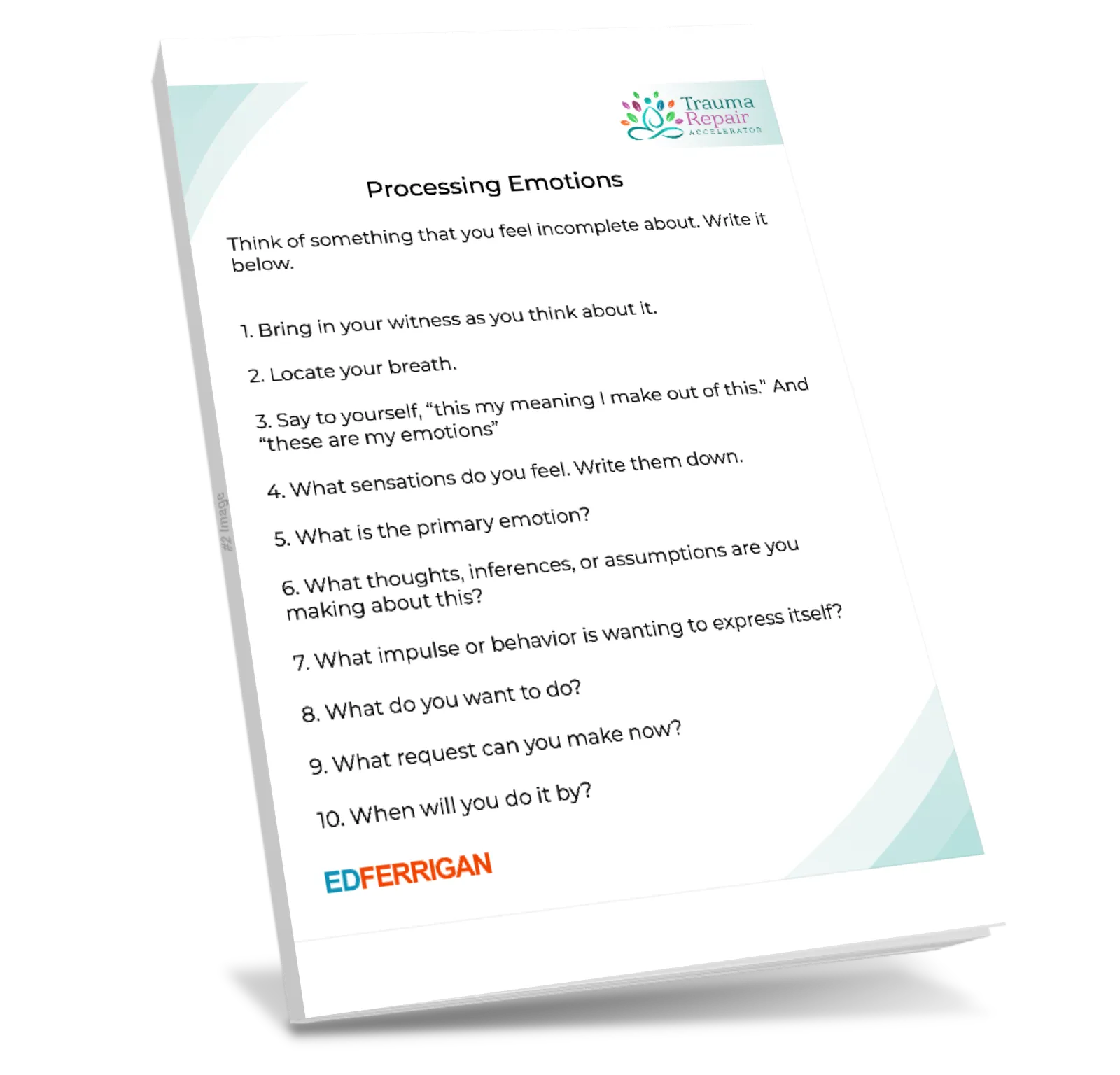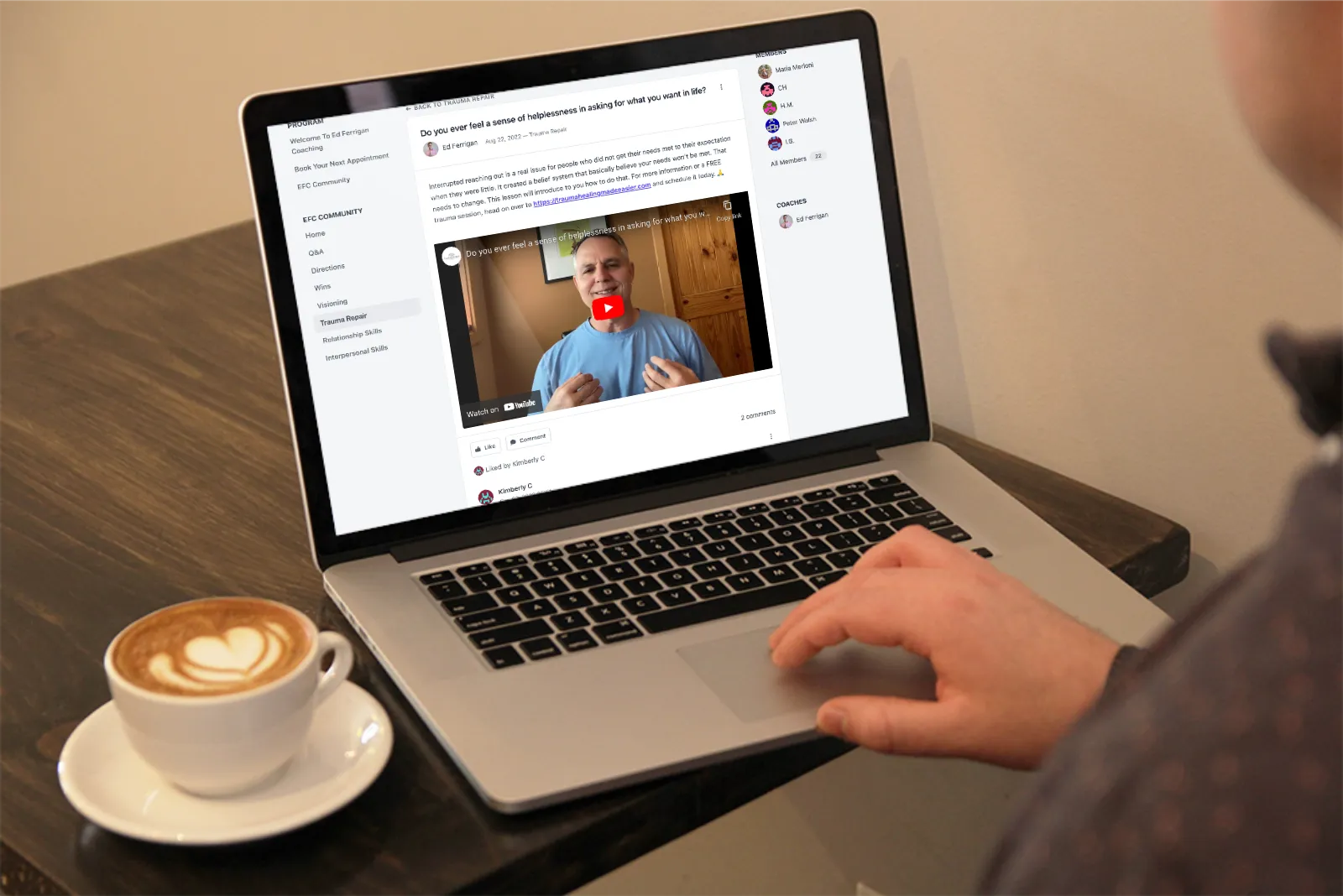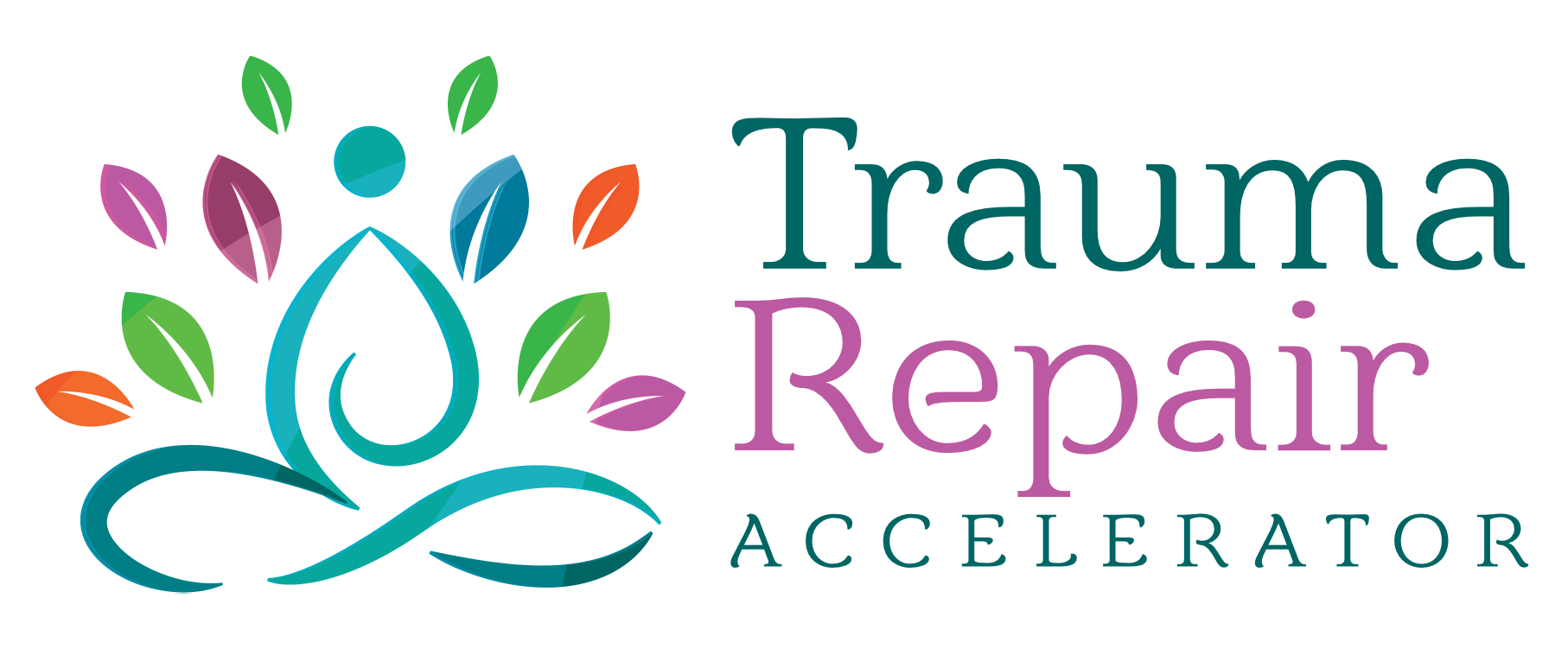Imagine your life without self-doubt, depression, binding shame, daily arguments, or chronic health issues...
THERE IS A VERY PRECISE METHOD OF RELEASING LIFE TRAUMA's THAT IS STORED IN YOUR BODY MEMORY SYSTEM. IT GETS TO THE ROOT CAUSE AND STOPS YOUR EMOTIONAL SWINGS DEAD IN THEIR TRACKS.
KEEP READING TO FIND OUT IF IT WILL WORK FOR YOU...
You will see a lot of life improvement programs today promoting how to have your best possible life. I have yet to see one of them address how your underlying trauma affects your ability to sustain the practices they recommend.
The effects of developmental trauma is not always easy to see. Unfortunately, most people who seem to stay stuck in life don't even know to ask about developmental trauma and what the heck it means.
So let me make this simple for you...
The results you are getting today are dictated by your past habits.
Here is how you can check for yourself:
The proof is to ask yourself "Are you happy with your current results?"
Look at your relationship, if you are in one. Are you happy?
How excited you feel day-to-day?
Do you like what you see when you look in the mirror? (e.g. physical appearance, self esteem)
How about your financial well being?
Are you in a career that you are passionate about?
Are you motivated to take care of your body?
In 25 years, and after working with several thousand people, have I NOT found a person that didn't have some kind of developmental trauma that is blocking some important success they want.
Here are examples in case you are still curious what I mean:
Low self worth (You get nauseated when you think of public speaking, get anxious before you try new things, negative self talk when you look in the mirror, or even disgust over your body or looks, depression)
Sense of not belonging anywhere (Feel lost, no or only a few friends, no one reaches out to you, one sided friendships, insatiable desire to feel like home)
Addictions (Over eating, drugs, sex-pornography, alcohol, binge watching Netflix)
Feelings of shame when things don’t go right (a sick feeling in your gut)
Fear of being seen (You avoid experiences that might expose you or draws attention to you)
Afraid to speak up (Shut down, get quiet, or even shrink when you disagree)
Regular bouts of feeling victimized (Negative whining tone when complaining to friends)
Fear of intimacy (Push people away when they get too close, sabotage relationships, pick people where you know it won’t work)
Fear of sexuality (Inhibited, frigid, avoid the conversation, avoid the situation, shame about exploring with your partner, or the extreme opposite behavior)
Financial issues (Struggle with jobs or self employment, Poor spending habits, Debt)
Arguing and fighting with partner
Discounting your talents (Negative self talk, shun or deflect appreciation from others)
What I have found is the recommended solutions by the “guru’s” don't address an underlying issue that causes you to return to your old ways - causing you to wonder why nothing seems to work.
You start with good intentions. You do everything they tell you to do. You create a "system" to make sure you follow through. Then suddenly, an impulse or distraction redirects you. It could be another method or system that you imagine might get you there faster. So you ping over to another program thinking "It" will finally be the "holy-grail."
As you look back over the years, it's easy to see something has gone wrong and maybe regret sinks in. The challenge though, after so many trial runs, is to believe anything is more than just another "program or system" to entice you. Now, you don't even trust yourself to know the difference.
I finally learned how to put a stop to the nonsense and I want to share that with you today.
A couple years ago, I went back and reviewed hundreds of sessions I had with clients. After highlighting and cataloguing hundreds of remarks and role plays we practiced, I saw a common thread amongst the sessions where clients reported breakthrough success. I then filmed lessons for each of the practices and principles I discovered.
You can now access this information below.
The goal of the program is to give you the essential tools to make you aware of any developmental trauma that is still interfering with your success today. As you practice the lessons, you will begin to see the habits, patterns, and beliefs that have always been there, right under your nose.
I will then show you how to identify them and what to change to get a better result.
And I won't sugar coat this for marketing reasons. Your coping mechanisms and beliefs get modified the more you practice. Feel free to send me an email at [email protected] if you have any questions.

The first part of the program orients you on the basics of trauma. It’s like having a map of the terrain so you can plot your course. You will learn the language of trauma so you can articulate your experience and stay excited about the practices in part two and three that begin the transformation process.
Learning these basics will be like learning the A,B,C’s in grade school. Once you understand them, you will have more hope and confidence moving forward. The goal of this part of the program is to assist you to move forward with confidence and trust in the process and where it is taking you. Get ready to feel the excitement of having your life back.
Lesson 1: Grounding – In this Grounding lesson, you will learn one of the most important life-tools for getting back to "ground zero" so you can sort things out without so much stress. Grounding will help you to feel settled so you can think straight and make better decisions.
Lesson 2: Activation-Regulation Cycle – In the Activation-Regulation Cycle lesson, you will learn to frame your experience in terms of energy rising and falling. This will make it easier for you to catch yourself getting triggered and to know what to do to self regulate better.
Lesson 3: The Four F's – Our innate tendency to move into a fight, flight, freeze, faint response when fear is active. This principle is also at the root of all trauma. When you finish this lesson, you will be able to tune into your body and know when you are in a fear based response. You will then learn, throughout this entire course, activities you can use to resolve that activation so in the future you are far more resilient and respond with curiosity rather than fear.
Lesson 4: Stimulus-Routine-Reward Model – In this lesson, you will learn about the dynamics involved in building a habit. We are creatures of habit. Often those habits begin as a reaction to our environment. It's hard wired into us to scan our environment and respond in a way that guarantees our survival. When you finish this lesson, you will be able to interrupt the response to the stimulus so you can redirect into a response that will get you better results.
Lesson 5: Orienting – In this lesson, you will learn about Orienting. Imagine walking into a new grocery store and looking for something you need. You scan around looking for sign above the aisle to narrow your search. Orient is just like this only you are doing it inside your own body experience. In time, as you orient to your responses to life, you’ll become very skilled on how to move into a healthy response rather than a coping mechanism that only works temporarily.
Lesson 6: Discharging – Think of discharging as releasing energy that has been stuck in the body. When you finish this lesson, you will be able to tune into your body and know the difference between feeding fear in your body versus organically releasing the energy, through your breath, that is trying to move.
One of the fastest ways to heal trauma is to bring to light the beliefs, decisions, and things you do that keep it active and unresolved in your body. Trauma is stored in your implicit memory system. This memory system is on autopilot. You have emotional energy, assumptions, beliefs and coping mechanism stuck there.
In part two of the Trauma Release Accelerator, you will learn several ways to identify these patterns so you can interrupt them and finally find resolution. My Tibetan teacher used to tell me, “You need to plug the holes in your leaky bucket.” Good advise as I look back 25 years later. Together, in this program we will repair the leaky bucket!
Lesson 1: Visioning For Success – In this lesson, you will learn about the value of visioning. Think of visioning as designing a specific intent to guide you. If we are not clear about our desired goal then our unconscious will react and not necessarily in the direction you want it to, especially if the steps you need to take seem scary. Visioning allows you to more clearly see the results you are getting so you can more easily see what you are doing that is working against your desires. When you finish this lesson, you will be able to get a better idea what success looks like and be more aware what to do differently if the result you are getting are less than your expectations.
Lesson 2: CAMBS Model – In this lesson, you will learn the C.A.M.B.S. Model. The CAMB Model is a framework for seeing your unconscious patterns more easily. When you finish this lesson, you will be able to see more clearly what you could not see before. Then, it's up to you to take the necessary steps to modify your pattern to get a better result.
Lesson 3: Fear Based Strategies – Fear based strategies keep us stuck in the past and getting less than optimal results. You'll learn some of the most common patterns that humans consistently resort to based on fear and how to counteract them. When you finish this lesson, you will be able to interrupt any of these common patterns and have more choice about what to do instead. The goal is to give you more choice moment-by-moment ultimately aligning you more with your heart's desire.
Lesson 4: Transitions Opener – Transitions in life are fertile ground for discovering unconscious destructive behaviors that diminish our well being. In this series we will look at the different dimensions of transitions based on the work of William Bridges.
Lesson 5: Transitions Endings – Ending stage is of the Transitions Model. When you are letting go of an old belief or bad habit, you are in the ending stage. You will learn what "Endings" look and feel like and how to navigate that stage in your life with more grace and ease. When you finish this lesson, you will be able to recognize the stage you are in when it comes to life transitions and how to navigate it with more ease and flow.
Lesson 6: Transitions Neutral Zone – The Neutral Zone is the time that exist between endings and new beginnings. Remember, the brain doesn’t like the unknown so in this stage your brain often relies on fear based thinking and can tend to be skittish. In this stage, you want to be very purposeful in how to navigate as your brain re-orients to new ways of doing things. In this lesson, you’ll learn what "Neutral" looks and feels like and how to navigate that stage in your life with more grace and ease. When you finish this lesson, you will be able to recognize the transition stage you are in and how to navigate it with more ease and flow.
Lesson 7: Transitions New Beginnings – In this lesson, you will learn what the New Beginnings stage is of the Transitions Model. You will learn what "New Beginnings" looks and feels like and how to navigate that stage in your life with more grace and ease. This is an exciting lesson. Towards the end, I will provide a nice checklist of how to know when you are in this phase. When you finish this lesson, you will be able to recognize the transition stage you are in and how to navigate it with more ease and flow.
When you get acquainted to your inner landscape you receive a gift. The earlier in life we start feeling bad the more identified we are with the pain. When we are little we cannot discern that others are actually the problem. We then make a meaning out of what our bodies mean to us. Most of the time it’s not good.
In this Module, you’ll learn how to disassociate from the old feeling and who you thought you were and re-associate with the real you. After you work your way through this section, you will learn to appreciate how the body is always giving you feedback now that you know how to listen.
Lesson 1: Presencing – In this lesson, you will learn the power of presencing. How to be in the heart and now. When you know how to presence yourself, you take back command of your experience.
Lesson 2: Naming Emotions – In this Naming Emotions lesson, we will revisit the importance of naming emotions to help self regulate the brain. When you are able to pause and name the emotions you are experiencing, you are slowing the brain down and helping it to reorganize itself. Over time, this practice will create a sense of calmness and it will be easier to "unhook" from any triggers.
Lesson 3: Processing Emotions – In this lesson, you will learn how to process emotions so they don't get stuck in your body. You'll learn how to use your breath and to suspend thoughts so you can move energy instead of locking it down in your body. When you finish this lesson, you will be able to tune into your body and breathe through intense emotions and organically release the energy so your memory system stays in "real time" rather being stuck in the past.
Lesson 4: Tracking Sensations – In this lesson, you will learn the importance of tracking sensations. Tracking sensations trains you to get out of the left brain and back into the right brain where integration happens. (In reality, you are learning to be in both parts of the brain in a balanced way.) When you finish this lesson, you will be able to recognize when your thoughts are getting in the way of just feeling and breathing. Feeling, tracking sensations, and breathing are the key ingredients to complete integration. Life gets easier and your intuition will grow rapidly the more you practice tracking sensations.
Lesson 5: Self Love – In this lesson, learn the value of loving yourself. You will also learn the steps to rewire any negative belief into positive thoughts about yourself. The brain cannot tell the difference between you loving yourself and someone else loving you. Self love gets programmed into us when we receive love from others growing up. If that did not happen we need to repair that part of our psychology as it creates trauma when we don’t receive it.
Lesson 6: Wants & Needs – Today, you will learn to get back in touch with wants and needs. When we are little, our parents and society imposes rules on us that can cause us to get out of touch with our desires. This lesson will start you back on the journey of reclaiming them. When you finish this lesson, you will be able to recognize when you have a need or want and to speak out about it or to take action on. Doesn't mean you will always get what you want, but you will no longer be suppressing your impulses and you will learn to refine what matters and what doesn't.
Lesson 7: What's In My Control – In this lesson, you will learn the importance of stepping back and asking yourself "What is in my control here." This is an important skill to have because it will save you a lot of anguish and stress caused from unnecessary processing of information that is out of your control. When you finish this lesson, you will be able to recognize when to let something go and surrender to trying to change something out of your control.
Lesson 8: Loving "What is" – In this lesson, you will learn the importance of not resisting your current experience. That's why we call it "Loving What Is." I have a saying I like that goes like this: "The amount of pain we experience in life is equal to the amount of resistance we have to "what is." My goal in this lesson is to help you to turn off defensiveness or reactions and instead move into openness, curiosity and wonder. The end result is you will navigate life with more ease and flow.
In this section of the Trauma Release Accelerator, you will learn a multitude of new skills that will consistently give you relief. Over time, and with regular practice, you will soon feel the relief that comes from these practices. One of my teachers, Dr. Peter Levine, says, “Good trauma therapy is when the client is feeling better and they don’t even know how it happened.”
The practices in this section, will slowly discharge the pent-up energy in your nervous system. As this happens you’ll organically begin to see life from a new lens, end the coping patterns, and change your beliefs about the world permanently. Then you start getting better results without so much effort.
Lesson 1: Witness Observer – It's important to learn how to develop your internal observer or witness. Just imagine getting triggered by something someone said. Then imagine a voice in you that say's "Oh look, this is what is feels like to be triggered." That's the witness part of you. Practice this a lot and watch how quickly you recover from stress that takes over in your body.
Lesson 2: Resourcing Yourself – Think of resources as things that help you out in some way. Money that pays the bill and food is a resource. In the case of trauma healing, resources are the things you focus on in any given moment to provide relief. For example, imagine for a moment you feel triggered and scared. To access a resource you might look outside of yourself. Maybe look outside and notice what draws your attention that feel positive. Then simply focus on that for a while. In time you will feel some relief. Many of us already have resources we turn to without even realizing they are called resources.
Lesson 3: Attunement – Attunement is when you feel into someone and try sensing what they are wanting, needing, or trying to communicate. It's the ability to let go of control or your perspective and instead opening up to what is going on in the other person. Being curious is a key attribute to healthy attunement.
Lesson 4: Tracking Your Breath – Learn to turn off the thinking part of your brain and instead engage the "feeling" part of your brain will speed your healing-integration process. What moves things along faster is simply learning to stay connected to the breath to keep energy flowing in your body.
Lesson 5: One Breath "What is true" Statements – One breath statements teach us a couple of things. First, it teaches us to not go to the left brain all the time to rely on a solution. We need to process with both sides of the brain to have full integration. When we make a one breath statement of truth, we feel stronger even if we don't like facing what the truth is. One breath statements also help us to get to the underlying issue faster than speculating at what might be going on. Telling the truth one step at a time and feeling how our body responds provides a beautiful gateway to resolving any underlying issue faster.
Lesson 6: Pendulating – Pendulating is a technique to get relief. The brain loves putting things in buckets or organizing concepts. For example, pick any issue for you that has a lot of fear connected to it. Now pick one hand to represent fear. Feel that until you have a sense what fear feels like in your body. Use the other hand represents the meaning you are making out of something. Now feel into what meaning you are making out of the situation. Notice how that feels. Now go back and forth between these two separate issues. Notice how your body responds. Go slow and take your time.
Lesson 7: Notice What is Different – Trauma causes us to become fixated on a very narrow field of perception. We want to expand that. When we ask ourselves, "What is different or changing here?" it moves us into new possibility. It weakens the fixation. I highly recommend, anytime you find yourself wanting to be right about something ask yourself "what else could be possible here?" Then, be open to other thoughts and information in your environment. Especially others perspectives.
Lesson 8: Power of Meditation – Meditation is the #1 daily practice to heal trauma. Practice this exercise daily for at least 5 minutes and ideally longer. If you find yourself wandering in your thoughts the simply return to the breath and the feeling connected to it. Work up to a slow 15 second inhale and 15 second exhale. Make it a ritual every morning before you begin your day.
Bonus #1: Momentum
Many people fear if they open pandora's box of processing old traumatic events they will stop the momentum in their life. This eBook called Momentum will show you ways to avoid that from happening.
Bonus #2: Co-Creating
In this eBook you will learn the steps necessary to go from arguing and distancing behaviors to instead supporting each others light.
Bonus #3: SHIFT
In this eBook you will learn the AWARE 10-step process for navigating any change and to regain awareness – then immediately stop the old habit from taking control. When you master the AWARE process, you will no longer be a victim of your past experiences. Instead, you'll know exactly how to unpack your experience so you can see you are reliving from an old memory not by conscious choice. Of course, we all want to be living through conscious choices.
Trauma is about energy stuck in the nervous system NOT the event. When you release the “stuck” energy, your body begins to self regulate and feel safe again. Only then, can you achieve a fulfilled life.
- Ed Ferrigan, Creator of the TRA-10 Trauma Healing Model
If you are a human being you are vulnerable to trauma. In particular, early life or developmental trauma is insidious. Most people who have been traumatized in life had issues happen to them so early in life they don’t know what it is like to be without it. I was one of those people.
Fortunately I had the awareness that something was wrong and continually sought out help. By the time I was in my late 20’s I knew life was way harder than it needed to be. But I was at a loss to know how to correct it. But I stayed open. Always learning. Always growing. By the time I was 35 I had had enough. My mother passed away and I went into post traumatic stress.
This is when I started to realize there was something very powerful about the unconscious memory system in our bodies. I sought out to understand how it worked. Then in 2004, I had another severe case of PTSD after an unexpected break-up. This is when I learned and started practicing Somatic Experiencing. A unique process for releasing trauma from the body. It changed my life. Over the next few years, I got certified as a practitioner. Many of the tools you will learn in the TRA-10 process came from this training along with intense studies on attachment theory and neurological science.

Part 1: Trauma Basics
The Activation-Regulation Cycle Explained
The 4 F’s of Flight, Flight, Freeze, Faint
Stimulus or Cue, Routine, Reward Model
Orienting
Discharging
Part 2: See Your Blindspots
Visioning For Success
The C.A.M.B.S. Model
Naming Emotions
Fear Based Strategies
Transitions
Broken Agreements
Part 3: Refriend Your Body
Tracking Sensations
Naming Emotions
Wants & Needs
What's in Your Control
Learning to Love "What Is"
Part 4: Loosening The Grip
Witness Observer
Resourcing Yourself
Attunement
Tracking The Breath
Tracking Sensations
One Breath "What is True" Statements
Notice what is positive & different

Integrate each video with a weekly prep email describing the situation and how to apply what will be in the next video. It tees up the next lesson in a way you are eager to watch, practice the lesson, and know how to apply it. Each week you’ll get a specifically designed email to open the lesson, offer insights, and help you frame up how to think about the video as you work your way through it. It will keep you motivated and offer you timely insights. ($150 Value)

Along with each video and emails you will have PDF worksheet to follow for each exercise. It will help you to have recorded notes of what is working and what you need help on. ($100 Value)

There is a feedback button on every video-lesson page that keeps me informed and a pulse on what lessons need adjustment or additional lessons. I regularly monitor this feedback and when needed will offer weekly on-line sessions to clarify concepts, exercises, or how to handle specific situations. (no charge)

One of the biggest challenges with integrating any new information is how our brains are wired to like patterns. Until you experience something, you will not know if your pattern is promoting your learning or resisting learning. What we know for sure in brain science is our brains can change but you must give it a reason. Learning from others is another way to embody the TRA-10 concepts. I encourage you to utilize this private group and save yourself a lot of time and money. ($300 Yearly Value)
For the time being I am offering lifetime updates to the Trauma Release Accelerator. Neuroscience, trauma research, attachment theory, other up-and-coming psychological models and my own insights continue to refine my knowledge of the principles and I want to continue to share them with you. It is one of my life goals to create a program that has the potential to change the world. The Trauma Release Accelerator or TRA-10 System is the foundation of that. ($300 Value)



Click the button below to get started and within a few minutes you’ll have access to the Trauma Release Accelerator


Step-By-Step Video Lessons For Learning Self Regulation ($595 Value)
Advanced E-Learning via Email Lessons ($100 Value)
Worksheets to supplement the lessons ($20 Value)
Group Feedback For Upgraded Lessons ($100 Value)
Lifetime Updates ($300 Value)
Private Discussion Group ($300 Per Year Value)
12 Personal Recorded Zoom Calls with Ed Directly ($1800 Value)
Step-By-Step Video Lessons For Learning Self Regulation ($595 Value)
Advanced E-Learning via Email Lessons ($100 Value)
Worksheets to supplement the lessons ($20 Value)
Group Feedback For Upgraded Lessons ($100 Value)
Lifetime Updates ($300 Value)
Private Discussion Group ($300 Per Year Value)

Ed Ferrigan has been running his own practice since 1997. He has a Masters in psychology from Antioch University, is certified as a Co-Active Coach From The Coaches Training Institute, certified as a Family Constellation Facilitator, certified in The Hendricks Body Centered and Conscious Relationships Program, and has the highest designation in the Peter Levine's Somatic Experiencing Trauma Healing Process. Has worked with over a thousand happy clients in the past 25 years...
This is a good question. I've done my very best to select and assemble 25 years of research and field testing with hundreds of traumatized people I’ve worked into a system that is easy to see the results.
And there are some other indicators that I think create a solid container for trusting this process...
My mentors, a group of the most dedicated trauma researchers who have been in the trenches for 30+ years (John Gottman, Gay & Kathlyn Hendricks, Allan Schore, Bessel van der Kolk, Larry Heller, Peter Levine, Pat Ogden, Susan Johnson, Harville Hendricks, Bert Hellinger, and dozens of others)
Information validated by thousands of therapists who use these tools
Tools designed and researched by the best in the business
Results from my own clients who's lives have drastically changed for the better
I personally use the tools daily and experience the results to determine what works and what doesn’t and what you have to do to implement them
That I too have been through the trauma healing struggle and got through to the other side
I know what it takes to work through life's worst stuff (like losing a job, wife, and 30 years of personal savings ...all in one month)
And I know what it’s like to drop the mask of trying to fit in and finding the real you underneath it all… so you approach life from an authentic perspective
Trying to live life with trauma is like living in a house of cards. This program will help you to rebuild your house with a solid foundation.
Sometimes people are just not ready. I have found that some people are coerced into coming to therapy and unfortunately that never works. There is often not enough motivation or understanding of the value.
You see, in the past when they reached out they got slammed so why would they want to reach out now?
It can be terrifying for people who got "less than adequate support" over-and over-again when they were little to reach out later in life. It can literally seem like a life-or-death choice.
I get it. I was one of those people. I tip-toed into therapy.
Most people that could use the help need a lot of motivation to overcome the beliefs they acquired when they needed help early on.
Often, there is zero trust in others. (This is a perfect example of how your unconscious motivates you out of your awareness.)
There are certain signs of people who won't make it in any program. (Continuous excuses, lack of commitment, avoidance, no follow-through, not doing the homework, showing up late, not creating a private space to process)
If you relate strongly to any of the points below, consider it may be a challenge for you to succeed - even though you may have a "hint" of desire...
Here are some signs to pay attention to...
If you are fed up and don’t want to try any more
If you want to continue to blame others for your problems
Believe in keeping secrets from those you love
It seems too scary to investigate what it takes to change old patterns
Deathly afraid of what truth you might find out (hint: it's never what we think it is...)
People who are afraid of psychology and resist others perspectives for fear of losing control
If you are closed minded and ego driven
If you don’t want to change and think other people will have to change
People who jump from one therapist (or coach) to another blaming the therapist
People who don’t want to admit when they are wrong
And a biggie… if you justify money as the barrier to getting help (yes, there are some people who flatly cannot afford my services and they are not who I'm referring to here :))

My heart wishes you goodness in life and I look forward to seeing you in the program.
Blessings today!
